When Caledon Was Made: Tales of Conflict and Triumph From the Early Days
A rural route by any other name? Where to put the blue bins? A memoir from Caledon’s first public works architect.
In 1966, I started my career with the former Township of Chinguacousy as an engineering clerk for the public works department. My varied duties included purchasing and inventory control. After some time, I was promoted to supervisor of operations in charge of the maintenance of water, sewer and roads departments. I was also responsible for garbage collection and landfill operations.
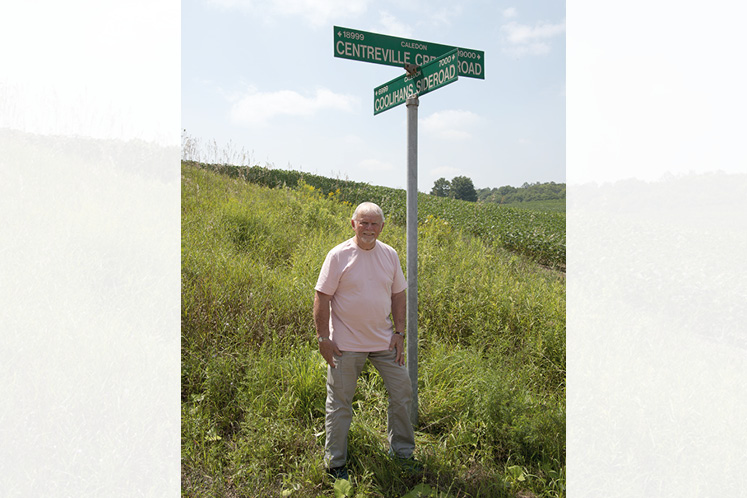
In 1975, Bert Moore was the first director of public works for the new Town of Caledon. His duties included coming up with names to replace the numerical system of the town’s lines and sideroads. He’s seen here this summer next to road signs bearing two of the names he chose. Photo by Pete Paterson.
In the early 1970s, the province of Ontario, under Premier Bill Davis, examined the structure of municipal governments and recommended a move from the county system to a regional system, deemed to be more in line with urban growth and development. As a result, the Regional Municipality of Peel Act was passed to abolish the County of Peel and replace it with a regional government, effective as of January 1, 1974.
The new Region of Peel consisted of three large municipalities:
- The Town of Mississauga (later changed to the City of Mississauga) encompassed the old Township of Toronto and the villages of Streetsville and Port Credit.
- The Town of Brampton (later the City of Brampton) was made up of the existing Town of Brampton and the surrounding area known as the Township of Chinguacousy and part of the Township of Toronto Gore.
- The Town of Caledon was created from the former townships of Caledon, Albion, the northern part of Chinguacousy and the villages of Caledon East and Bolton. Under the Act, the new town was originally called Albion. Later the new council held a vote to let residents decide the town’s name. There were three names to choose from: Cardwell, Caledon and Albion. The residents chose Caledon.
The three municipalities each had its own council and staff, including departments responsible for public works. For amalgamation to deliver the efficiencies it promised, the new municipalities had to thoroughly examine all operations, decide how and where to merge, and begin to craft new organizational schemes. Caledon, for example, covered 688 square kilometres and included four town halls, six volunteer fire departments and two public works yards.
The Township of Chinguacousy required me to check the “meets and bounds” (legal boundaries) of the new Town of Caledon. The southerly boundary was to be what is now Mayfield Road (with a jog around Snelgrove which would be included in the City of Brampton).
Allocating assets
Chinguacousy’s assets were to be transferred to Brampton on January 1, 1974. These assets included all buildings, funds and equipment, such as trucks and graders. This presented a significant challenge for the Town of Caledon, which was responsible for the new area – without the assets to carry out the required tasks.
The Regional Municipality of Peel Act guaranteed all former township employees a position with the new municipalities, although it did not guarantee the same position and pay. Accordingly, I applied for two positions: one with Brampton and one with Caledon. Both municipalities offered me positions; I accepted the job with Caledon.
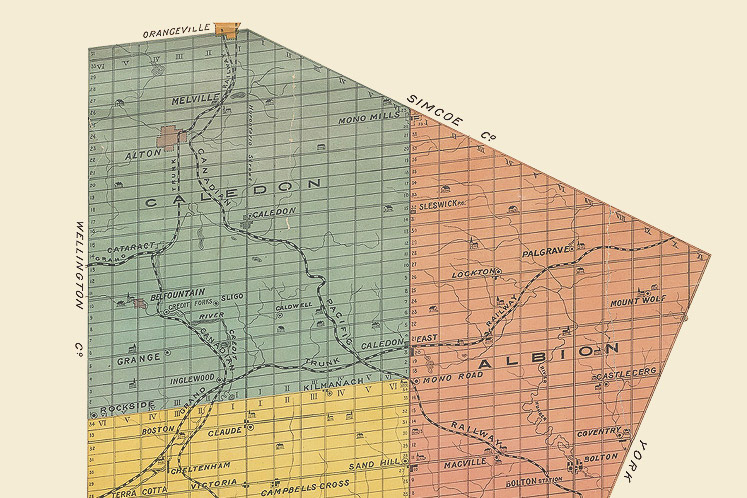
A section of an 1898 map of Peel County shows the former townships. The map was created by The Canadian Map Publishing Co. for the Brampton Conservator newspaper.
The first major issue I had to deal with was winter maintenance north of the former Township of Chinguacousy. I discussed my challenges with Brampton and was granted my request for the use of the trucks, loaders and graders formerly in Chinguacousy. This also gave Caledon time to budget for the acquisition of new equipment. Caledon had to return the borrowed equipment to Brampton at the end of the winter season, so the council decided to go shopping for the required equipment rather than go through a lengthy tendering process. My concern was that the councillors would be unable to source the appropriate dump trucks which would require increased carrying capacity for plows and wings.
As of January 1, 1974, my administration staff and I were scheduled to move to the former Township of Albion office on Highway 50 – but were without any office equipment. To remedy the untenable situation, I loaded my pickup truck with all the necessary equipment from the Chinguacousy public works department before that date and quietly stored it all until our relocation.
While working for the Township of Chinguacousy, I found the outdoor staff members to be loyal and dedicated to their positions as truck drivers, grader operators and labourers, particularly during winter. This was extremely reassuring to me. To my relief, with amalgamation, I found my new team was just as dedicated as my original staff.
As seems to happen with change, some of the outdoor staff had not been happy with the process and felt they should not have to work in the areas of other townships. I reminded them their paycheques now said “Town of Caledon” and that those original townships no longer existed.
I divided the town into three maintenance areas, each with a road foreman and a road superintendent overall. My choice for road superintendent was a very knowledgeable individual from the former Township of Albion. I was also able to hire three excellent foremen from each of the three townships.
Roads by any other name
One of the significant challenges facing the town was the duplication of rural road names that resulted from amalgamation. As a result, many emergency responders found themselves travelling to incorrect locations. For example, Albion Township had a 4th Line; Chinguacousy and Caledon townships each had a 4th Line East and 4th Line West (numbering from either side of Hurontario Street, aka Highway 10). One councillor living on the 4th Line East Chinguacousy owned a small plane. Unfortunately, the aircraft crashed during an attempted landing at his private airstrip. An ambulance was dispatched, but it went to the wrong 4th Line, creating a potentially life-threatening situation. The various fire departments faced similar problems.
A rapid solution had to be found. So council formed a committee to study the issue and resolve the matter. The committee included the town engineer, fire chief and public works director. Concurrently, the fire chief and I were working on a system of assigning emergency property numbers for all rural farms and residential homes.
Initially, I thought we could renumber all rural roads and keep the rural-sounding names. From west to east, the town would have 24 north-south lines. The east-west sideroads would be numbered from 5 Sideroad to the 40 Sideroad. However, the committee felt this approach would be even more confusing to the residents. For example, the 4th Line of Albion would become the 16th Line, and so on. After much discussion they all agreed that renaming the roads was the best alternative.
I was assigned to come up with names for the committee to consider. For some guidance I used three books: Looking for Old Ontario, The Illustrated Historical Atlas of the County of Peel, Ontario (1877) and Place Names of Peel, Past and Present.
The three municipalities agreed to not duplicate any name in the region. This caused me some problems. Notably, Brampton had used many names of hamlets within Caledon. I tried to avoid using any family names, but this proved to be impossible. Finally, the committee agreed with the name suggestions, and I presented a report to council, which stated the current name, the proposed name and the reason for it. Council did not adopt the report and requested that we hold public meetings regarding the proposed names.
Opposition from the public against road naming was fierce. Some residents went so far as to ask the province to investigate the town council. Each week, the local newspaper contained increasing numbers of negative comments from citizens who felt that there was no need to change and that educating new residents was the simple solution.
Some of the public meetings were heated. However, strong support for the system came from the fire department, police department, ambulance services and utility companies. We completed the series of public meetings and with some further input from the public and council members, a few further changes were made to the proposed names. Another bylaw was prepared, but again some councillors did not support it. During discussions, a motion was approved to rename only the roads in Ward Two (formerly Chinguacousy).
At one public meeting, a group of residents from 35 Sideroad (in former Albion Township) expressed vehement opposition to the proposed name of Coolihans Sideroad. I explained the reason behind the name: a small hamlet east of Mono Mills in northern Albion Township at this location in the 19th century had been known as Coolihans Corners, after Mr. Coolihan, who operated a hotel there. It was located on the northwest corner of Lot 36, Concession 3, on approximately five acres. The hotel’s hospitality was of high quality, so this modest place had become well known at the time. After the residents understood the background, they agreed on the name.
Sadly, it wasn’t that way at all the public meetings. At another one, the name Kennedy for the 1st Line East of Highway 10 was proposed, and tempers ran high. One attendee was so furious I thought he would hit me. Seemingly, road naming isn’t for the faint of heart.
Eventually, though, council passed a bylaw to name all the other rural roads. To implement the house numbering system, I temporarily hired two staff members and supplied them with a town pickup truck and a measuring wheel. Their job was to start measuring roads, sideroads and lines, and assign a number to a farm or residence at the location of their main driveway based on the reading from the measuring wheel.
Municipal numbers were assigned for every ten feet of frontage. In addition, a number was issued to the ten-foot section encompassing each main driveway.
Roads with a north-south orientation (lines), aligned with Highway 10, started with 12000 at Mayfield Road, the border with Brampton. They were issued incrementing numbers from 12001, with even numbers on the west side of the road and odd numbers on the east.
Roads with a west-east orientation (sideroads) aligned with Mayfield Road were issued even numbers on the north side of the road and odd numbers on the south side.
To maintain a consistent numbering grid on the rural roads that did not start at either the south or west boundaries, we had to use numbers that corresponded with the parallel original road allowances that began on the west or south boundaries of the town. This was due to the town’s topography, including curves and hills that sometimes necessitated adjustments.
Some property owners were unhappy with the numbers we assigned. Some minor adjustments were required because we had given a number for every ten feet. However, this numbering system has proven to be highly efficient and worked well for future property severances, as there is no need to change any existing numbers.
Funding the roads
Another major challenge facing council in 1974 was obtaining sufficient funds for the maintenance and reconstruction of roads. During the ’70s, the province provided road construction and maintenance subsidies. We were required to match this funding for roads each year and contribute 80 per cent for bridges and culverts. There were nine councillors and one mayor as members of council. Understandably, each member was focused on dealing with the problems in their ward.
To alleviate this challenge I suggested council members take turns allocating funds for annual road reconstruction. This concept worked very well for many years, but eventually the province ended the conditional road subsidy program and replaced it with unconditional grants. This presented the town with yet another financial challenge. It was given a lump sum grant and then left to make the most efficient decisions on how and why to spend it.
Recycling revolution
In the early to mid-1980s, recycling programs began sporadically emerging in various isolated areas of the province. This was driven by a combination of factors – the increasing pressure from the public to reduce the amount of garbage going to landfills and the emergence of blue box recycling prototypes driven by the City of Kitchener. Caledon was one of the first 40 municipalities to get on board.
Council initially requested staff to investigate the logistics of soliciting public and private funding sources, finding markets, procuring rolling stock, planning promotional opportunities, and engaging a suitable and reliable contractor. I met with Sandhill Disposal, our existing contractor responsible for curbside garbage collection, and we discussed several ways to start a blue box program.
The next step for me was to assign a roads department administrator responsible for spearheading and rolling out the program. Three of us attended various seminars on municipal recycling programs, aiming to develop the best possible individualized program for the town. As a result, funding was obtained and markets were located for container glass, plastic soft drink containers, food and beverage containers, and newspapers. Because household garbage comprises approximately 30 per cent recyclable materials on average, capturing this waste stream and recycling it goes a long way to lessening the volumes of residential material going to landfills.
Caledon was a significant frontrunner in innovative recycling concepts, and success ensued. We were proud the template we created was used in one form or another in many other municipalities.
Bypassing Bolton
The last project I was involved in was the Bolton bypass. Due to the heavy traffic going through Bolton on Highway 50, there was a need to find an alternative route. This caused some concern for the residents living on the roads we were considering. After several meetings, the residents convinced the province to bump the project to a full environmental assessment study.
I believed the traffic was regional, not local, and therefore should be Peel’s responsibility. I retired in 1999, and at that point the study was not yet completed. With the help of Emil Kolb, who had been on Caledon’s first council, served as mayor for two terms and then as chair of Peel Region, the study was taken on by the region and finally completed. It is fitting that one of the routes is named the Emil Kolb Parkway.
Throughout my long municipal career, I can honestly say I enjoyed my time with the Town of Caledon immensely. We are a large municipality in area and, when I started, small in population. The growth over the years has been exponential and continues to this day. We met the many challenges throughout the years with tenacity and persistence. To the best of our ability, we thought “outside the box” and I found the staff was hugely dedicated and the council receptive to new concepts.
Sometimes it was a fine line to walk, but I found an opportunity every day to bring my experience, dedication and genuine love of this community to the table. Mine was a long and varied career. I genuinely hope my involvement stands the test of time in this vibrant, ever-changing, beautiful municipality.
Related Stories
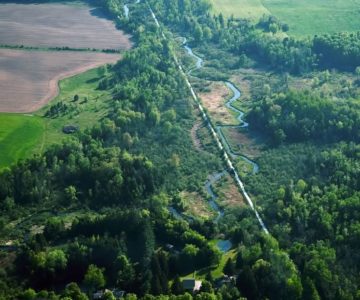
Finding Balance in Caledon: The Urban/Rural Divide
Jun 16, 2015 | | EnvironmentIn less than two decades Caledon’s population will be 75 per cent urban. Can its countryside values survive the shift?
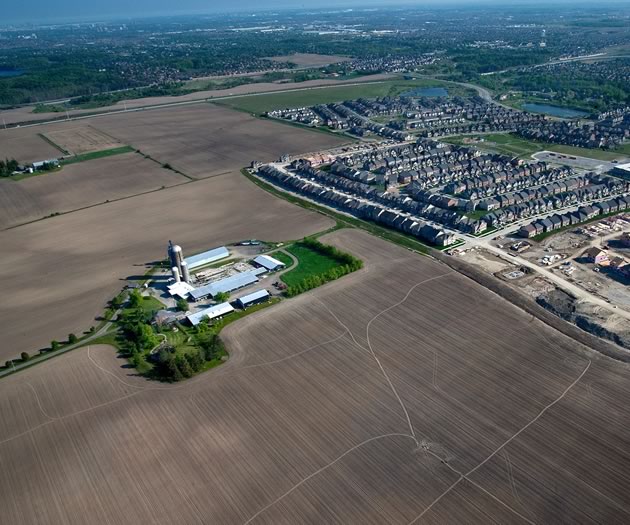
10 Years of the Greenbelt
Jun 16, 2015 | | EnvironmentOntario launched the Greenbelt Plan’s 10-year review, which is taking place concurrently with reviews of the Niagara Escarpment Plan, the Oak Ridges Moraine Conservation Plan & Places to Grow.

The Greenbelt: Letting the Belt out a Notch or Two
Mar 21, 2010 | | EnvironmentShould the Greenbelt be expanded? The central purpose of the plan is to protect farmland and environmentally sensitive land on the urban fringe.

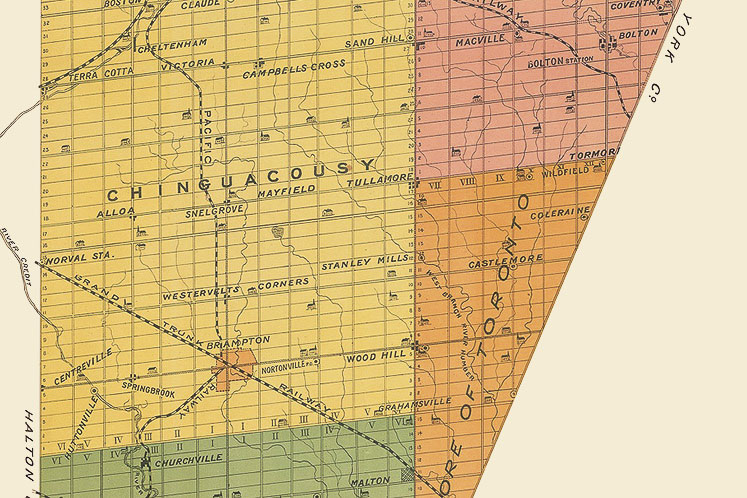
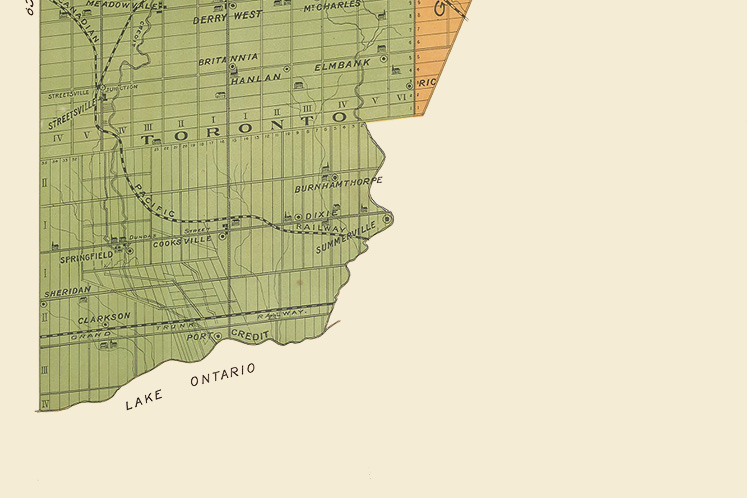







Very well written article by Bert Moore giving a good summary of Caledon’s history. On this article I would wish to know inte the road naming why roads names suddenly change as they go eat to the next Town or region rather than stay the same and why we have things like Airport road also named a highway 7 going North south but then crossing hwy 107 going east west which then turns into hwy 7 going east west at the Costco at the 427…al really confusing to me as I have only been here 2 years.
I would love to see him write an article on what he thinks as Caledon will undergo another transformation as the region dissolves and what he would recommend to the task force trying to deal with this.
Tim
Tim Donovan from Caledon on Sep 11, 2023 at 1:13 pm |